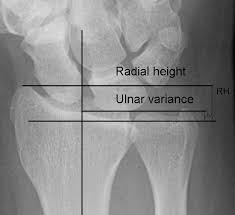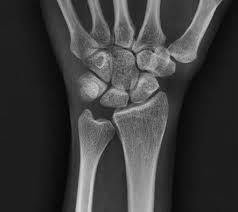Ulnar Variance and associated pathologies
Many wrist pathologies are seen to be associated with different values of Ulnar variance.
Positive Ulnar variance is associated with Ulnar abutment syndrome, arthritis of the ulnar quadrant of the wrist, Lunotriquetral ligament tears and Triangular Fibrocartilage complex (TFCC) tears. The thickness of the TFCC varies inversely with the Ulnar variance.
Negative Ulnar variance is associated with Kienbock’s disease and Ulnar impingement syndrome where the distal ulna impinges on the radius in the proximal sigmoid notch.
Some Common Conditions Associated with Abnormal Ulnar Variance
Ulnar impaction syndrome (ulnocarpal abutment syndrome)
This is a degenerative condition of the ulnar quadrant of the wrist and is a common cause of ulnar-sided wrist pain. This results in increased load bearing across the ulnar head, TFCC and ulnar-sided carpals, and subsequent degeneration of the TFCC, chondromalacia of the osseous structures involved (ulna and carpals, especially the lunate), and disruption of the triquetrolunate ligament.
Kienbock's Disease
Kienböck’s disease is avascular necrosis of the lunate bone. It is also known as lunatomalacia. This usually affects adults between 20-40 years of age and is more common in males involved in manual trade. Generally, it is found on one side of the wrist but bilateral care is non-unknown. The patients present with dorsal wrist pain with decreased grip strength. Proggresive loss of function is associated with carpal dysfunction and this is related to loss of function more commonly than the avascular necrosis of the Lunate bone.
TFCC and Ulnar variance
The main function of TFCC is to provide cushioning to the Ulnar carpus, stabilise the Distal radio-ulnar joint and the ulnar carpal bones. TFCC thickness varies inversely with the Ulnar variance. However the TFCC angle varies directly with the Ulnar variance. With positive Ulnar variance the loads on the ulnar side are compressive but these change to be of tension with negative ulnar variance. TFCC tearing is common with positive Ulnar variance as this is associated with thin TFCC.
References
1.
https://www.orthobullets.com/hand/6046/ulnar-variance
2. Katz DI, Seiler JG, Bond TC. The treatment of ulnar impaction syndrome: A systematic review of the literature. J of Surg Orth Adv. 2010; 19(4): 218-222
3. Yoshioka H, Tanaka T, Ueno T et al. Study of ulnar variance with high‐resolution MRI: Correlation with triangular fibrocartilage complex and cartilage of ulnar side of wrist. J. Magn. Reson. Imaging, 2007; 26: 714-719
4. Schuind F, Eslami S, Ledoux P. Kienböck’s disease, The Journal of Bone and Joint Surgery, 2008, 90-B: 133-139


